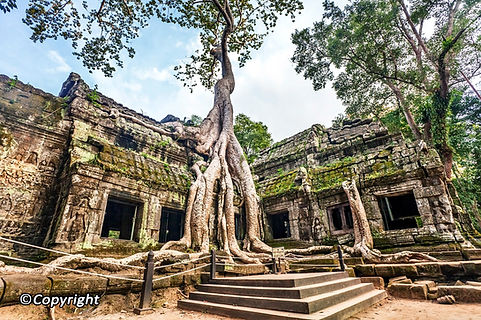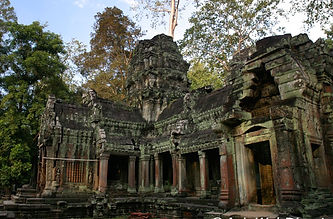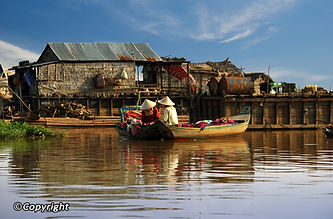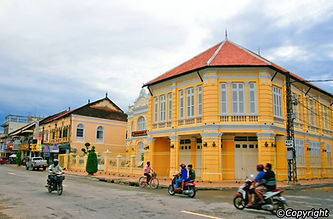CAMBODIA

Angkor Wat
Angkor Wat is the most famous ancient temple site in Cambodia, and visiting the ancient Angkorian temples is the reason most visitors come to Cambodia, and to Siem Reap. With its five lotus-like towers rising 65 meters into the sky, it is truly a monumental, and awe inspiring sight. This UNESCO World Heritage site was at one time the largest pre-industrial city in the world, and is considered one of the ancient wonders of the world. Angkor Wat is the crown jewel of any visit to the temples of Angkor.
The ruins of Angkor Wat are located in the Angkor Archaeological Park, and the entrance to the park is located about 3km north of modern-day Siem Reap. There are no hotels within the park grounds, and most visitors to the ancient temples stay in Siem Reap, using it as a base from which to make daily visits to the temples. The most significant temple ruins are found 6 to 25km north of town, with the closest major temple being Angkor Wat. The Roluos Group of temples are 13km east of Siem Reap.
It is best to arrange your tour of the Angkor Archaeological Park with a reputable tour agency and a knowledgeable tour guide. They can assist with purchasing the admission pass, and arrange the transportation you will need. There are also guidebooks available, which will help in understanding the history of the temples.

Phnom Penh Royal Palace & Silver Pagoda
The Khmer-style Throne Hall was built in 1866, to serve as the residence of the King of Cambodia, his family and foreign dignitaries, as a venue for the performance of court ceremonies and rituals and as a symbol of the Kingdom. South of the Throne Hall are the Royal Treasury and the Villa of Napoleon III, built in Egypt in 1866, for the opening of the Suez Canal, and was later presented to the Cambodian king as a gift.
The famous Silver Pagoda, originally constructed of wood in 1866, was expanded in 1962 by King Sihanouk who had the floor inlaid with 5,329 solid silver tiles, hence its name. Inside the Palace grounds, traffic noise is thankfully blocked off by the high walls and the various Royal buildings sit in tranquility amidst the manicured tropical gardens.

Bayon & Ta Prohm Temples
Aside from Angkor Wat, Ta Prohm and Bayon may be the best known and most photographed of the “other” temples. Ta Prohm is popular because of its lost temple in the jungle atmosphere, overgrown with trees and vines, and Bayon is famous for its huge enigmatic, carved stone faces.
The Bayon Temple is the dominant feature inside the walled city of Angkor Thom, and Ta Prohm is not far outside the Victory Gate of Angkor Thom. Both are Buddhist temples, and were constructed by King Jayavarman VII; Bayon in the late 12th century, and Ta Prohm from the mid 12th century to the early 13th century. These two magnificent examples of Angkor temple architecture should not be missed. See below for details of these two ancient structures.

Ta Prohm Temple
The temples of Angkor Wat and the walled city of Angkor Thom are perhaps the most famous and best known of all the ancient temple sites. To the east of Angkor Thom is the third most important, and one of the most photographed of all the ancient temples due to its dramatic scenery.
Ta Prohm is a quiet, and sprawling monastery, and unlike most other sites, it has only been partially cleared of overgrowth, and has been intentionally left more or less the way it was originally found. Some walls and doorways of the ancient structure were left overgrown and gripped by huge trees and other foliage. Flocks of parrots in the trees add to the atmosphere, and give the visitor the feeling of discovering a temple lost in the jungle. With this image in mind, it is not hard to imagine what the French naturalist Henri Mouhot must have felt when he ‘discovered’ the temple in 1860.

Tonle Sap Lake
The best time to see the lake is when the water level is high, and floating villages are truly floating, and trips to the flooded forest and wildlife reserves are interesting. Trips to the bird sanctuaries are best from December to April.
In the dry season, the lake becomes very shallow, and large boats sit on the bottom of the lake. During this time, villages on stilts are left high and dry, and floating villages move out onto the lake. Also, forests are dried up, and some bird sanctuaries cannot be reached.

Bamboo Island
You won't find TV or internet or even roads on Bamboo Island but what you will find is warm, blue, crystal-clear water, perfect for swimming, soft golden sandy beaches, lush natural surroundings, and a lot of peace and tranquility that you won’t come across in many other so-called ‘relaxed’ destinations. This is serenity at its best.
You’ll find footpaths throughout the island, so you can explore the jungle covered interior. There is a volleyball net on the beach.

Battambang
Battambang is somewhat of an ode to French colonialism. The city lies in the heart of the Northwest and until the war years it was the leading rice-producing province of the country. The 100,000-person town offers not only one of the best preserved examples of the French Colonial era, but also the small-town feel you expect to encounter in Cambodia as a rule. The true bonus however is the village life that is a mere stone’s throw away, be it by motorcycle, jeep or boat. The combined effect makes Battambang well worth the detour it requires to visit.
For centuries, Battambang was part of Siam and was used as its eastern commercial hub. The French have left a strong mark on the town's architecture, resulting in a pleasing colonial effect. The town is the gateway between Thailand and Phnom Penh but still retains a sleepy atmosphere not conducive to people looking for nightlife and fine dining.
Rather, people use the town as a base for visiting the nearby temples of Phnom Banon and Wat Ek Phnom. Some 293 kilometres from Phnom Penh, Battambang is in the heart of Cambodia's 'rice bowl' and even though it is Cambodia's second-largest city it has a marked rural feel to it.

Apsaras Dance & Dinner Shows
Apsara Dance draws its inspiration from the mythological court of the gods and from its celestial dancers, the Apsaras. The dance took on its own unique form adding movements and meaning, during the reigns of Jayavarman II and Jayavarman VII as well as in the Angkor era.
By the 13th century, the dance was assuming a Khmer identity rather than Indian – the source of its roots. It combined gentle movements with loud, traditional Khmer music during its performance. In that era, Apsara dance was performed solely for the benefit of the upper class, and particularly for the king.
Apsara dancers’ fingers are extraordinarily elastic; so much so that they can bend their fingers backwards almost to the wrist and training starts when they are so young that their bones are still supple.

